Through the Medical Device Regulation (MDR) and new version of ISO 14155, the regulatory landscape for clinical investigations with medical devices will significantly change.

In contrast with previous regulations, all Post-Market Clinical Follow-up (PMCF) clinical investigations will have to be conducted in compliance with the ISO 14155 standard. Although some PMCF investigations may be exempted from a number of requirements, the basic necessities remain applicable, such as implementing written quality procedures, monitoring and document management. Another necessity is using a compliant method of data collection and processing such as Castor EDC.
Background
On 26 May 2020, EU regulation 2017/745 (MDR) was scheduled to come into full effect, thus amending the Medical Device Directive (MDD). Although this regulation may be delayed due to the COVID-19 pandemic, now is the time to get organized and prepare to hit the ground running with clinical data collection.
The introduction of the MDR triggers significant changes to the regulatory landscape for medical devices and adds new requirements for clinical investigations. Namely, the MDR specifies that clinical investigations should be in line with ISO 14155:2011 on good clinical practice (MDR (64): p. 9) and that sponsors should provide evidence that clinical investigations are conducted in line with good clinical practice (MDR Annex XV Chapter III Point 6: p. 172). In addition, under the MDR both pre- and post-market clinical studies count as a clinical investigation, which extends the requirement to comply with good clinical practice to post-market trials, both interventional and observational types.
A new version of ISO 14155 is expected to be released in the near future, and a draft has recently been presented although not formally implemented (ISO/DIS 14155:2018). In its new version, ISO 14155 reinforces that its applicability extends to “post-market clinical investigations” and in Annex I further defines applicability for the various post-market types, including observational PMCF investigations. Because applicability of ISO 14155 extends to all clinical investigations that involve human subjects, this also impacts Investigator Initiated Studies (IIS) and registries. In addition, Annex I of the new ISO 14155 describes the clinical development stages of medical devices, including the applicability of the standard to every specific stage. For post-market observational studies, possible exemptions are indicated for device accountability, labeling for clinical investigations, need for an Investigator Brochure, reporting to regulatory authorities, full informed consent, and CVs of members of the investigation site team.
Because of the wide applicability of ISO 14155, this article discusses the impact of ISO 14155 on post-market studies, and specifically on observational post-market studies.
Quality procedures
Annex XV of the EU MDR discusses a sponsor’s obligations with respect to clinical investigations. Per ISO 14155 section 9.1, sponsors are responsible for clinical quality assurance and quality control, and therefore have to implement and maintain written clinical quality procedures to ensure that clinical investigations are fully compliant with ISO 14155, other applicable laws and regulations, as well as the Clinical Investigation Plan (CIP).
Relevant quality procedures may be integrated in the sponsor’s overall quality system. Examples of processes to be captured in these procedures include essential document creation (such as the CIP), document management, data collection and processing (data management), training, and monitoring. A set of well-written quality procedures is of great value to the clinical investigation as these procedures provide a clear workflow and distribute responsibilities within the clinical team. The key to successful procedures for post-market studies is to keep them flexible and practical.
Clinical quality procedures can be created by sponsors and implemented internally, however this may be a time-consuming and costly process. Alternatively, these procedures can also be acquired from an external source, as long as it is clear from the clinical investigation documentation which procedures were exactly used.
Clinical Investigation Plan (CIP)
According to the MDR Annex XV as well as ISO 14155 Annex A, when conducting a clinical investigation the CIP must include certain specific elements. These include a single identification number of the clinical investigation, identification of the sponsor and information on the Principal Investigator (PI), a description of the funding used to execute the investigation along with a synopsis, device description along with its clinical risks and benefits, aim and design of the investigation, information on the subjects, a description of the measures taken to minimize bias, details of the monitoring and data management plan, compliance statements, a description of the safety reporting procedures, etc. In addition, it is crucial that the CIP is written clearly to avoid possible misinterpretations. Finally, the investigation’s endpoints and parameters must be well described to facilitate CRF development.
To ensure the quality of the CIP, different stakeholders should review the plan prior to document finalization. For example, experienced monitors will be able to identify potential problems with in/exclusion criteria, whereas data managers may be able to provide input on endpoint description and timepoints for collection.
Informed consent
Because post-market studies may be designed as observational studies, the issue of informed consent can be difficult to navigate in certain circumstances. Generally, the notion of informed consent implies that study subjects must be informed of the risks associated with the investigational procedure and available therapeutic alternatives. However, with observational studies informed consent may not be fully required, but subjects must at least consent to sharing of their medical data—even though pseudonymized—for the purpose of the clinical investigation and for a sponsor representative to have access to their original medical records (ISO 14155 Annex I point 7d). Such a consent form is often referred to as a data release form. For European citizens and residents, the data release form must comply with GDPR requirements. Per GDPR, subjects must be informed on who the data processor and controller is for the clinical investigation and must receive contact details of a Data Protection Officer for the investigational site, the Sponsor, or both. Furthermore, subjects must be informed about their right to review their data as these are collected, make corrections, and be removed from the system if desired.
Data collection and processing
According to ISO 14155:2011 (6.8), all data shall be generated and maintained in a way that enables control and traceability of the data. The new ISO 14155 (7.8) adds reliability and integrity to these requirements as well as validation of electronic clinical data systems used to evaluate authenticity, accuracy, reliability and consistent intended performance of the data system. These requirements impact both the data generated and held by manufacturers and those generated in the setting of an IIS. As a result, both sponsor-generated and IIS-generated data must be collected and processed using compliant data capture systems and CRFs. In this context, using an established EDC vendor that offers a fully validated and compliant system as well as the opportunity to validate study-specific CRFs is of crucial relevance.
Data Monitoring and Document Management
According to ISO 14155, monitoring of clinical data is the act of overseeing the progress of a clinical investigation and to ensure that it is conducted, recorded and reported in accordance with the CIP, written procedures, ISO 14155, and other applicable regulatory requirements. Sponsors are responsible for identifying and using qualified professionals for this function and should evaluate the nature of monitoring that is appropriate for the specific clinical investigation. In addition, monitoring plans (MP) that outline the activities done per visit type (site initiation visit, interim monitoring visit, close out visit) as well as the type of reporting must be compiled. In exceptional circumstances such as for certain registries, centralized monitoring may be sufficient. For most post-market studies monitoring of primary endpoints may be sufficient, however this should be adequately justified in the MP (ISO/DIS 14155:2018 section 6.7; EU MDR Article 71 point 2).
The results of the assessments must be written in the monitoring plan (MP). The MP also describes the outline and activities done per visit type (site initiation visit, interim monitoring visit, close out visit) and the type of reporting required.
In exceptional circumstances (which may include certain forms of registries) centralized monitoring, without actual source data verification may be sufficient. For most post-market studies only monitoring of primary endpoints is considered sufficient but this differs on a study by study basis and needs to be justified in the MP.
Similarly, clinical investigation documents also must ensure control, traceability, reliability, and integrity per the new ISO 14155 Annex E. As a result, clinical investigation documents must contain a version and date for every revision made, as well as a description of the potential impact of the change on safety and performance endpoints and data sources identifiable to the subjects. These documents should be located at both the Sponsor’s and the investigator’s sites, as per overview provided in ISO 14155 Annex E. While maintenance of the Sponsor’s regulatory files is expected of the Sponsor, maintenance of the site files pertains to the investigator. The investigator is also responsible for the accuracy, attribution, completeness and legibility of the source data and the timeliness of data entry into the CRFs. All copies of source documents must be certified by signature of a member of the investigation site team. According to the new ISO 14155 (7.8.3), If an electronic system is used as the primary location of document storage and filing, the system must be validated in order to evaluate authenticity, accuracy, reliability, and consistent intended performance of the system. In Castor EDC, all validations can be easily performed and documented.



